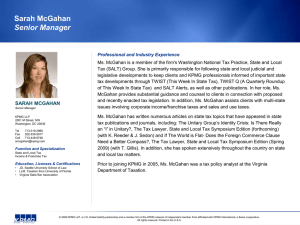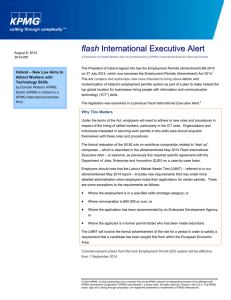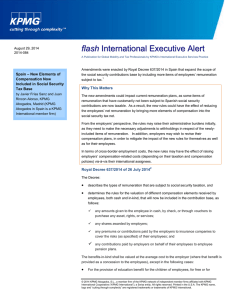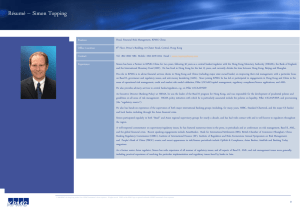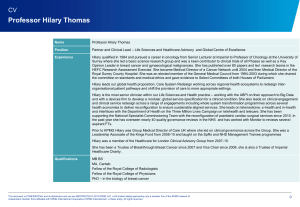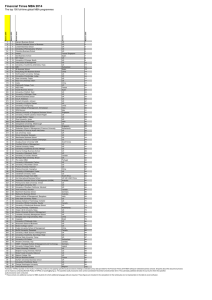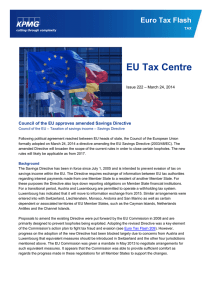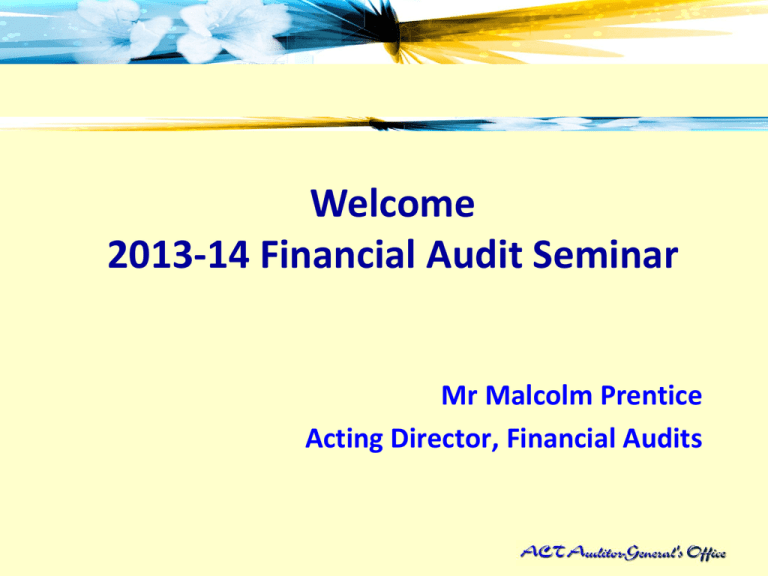
Welcome
2013-14 Financial Audit Seminar
Mr Malcolm Prentice
Acting Director, Financial Audits
Address by the Chair, Standing
Committee on Public Accounts
Mr Brendan Smyth, MLA
Key Audit Findings
from Past Audits
Mr Saman (Sam) Mahaarachchi
Audit Manager
Outline
• Audit Findings
• Computer information systems
• Risk management
• Other findings
• Quality of financial statements
Audit Findings
• Matters of governance interest
• Reported to those charged with governance
• Include:
- weaknesses in governance and internal
-
controls
Fraud
legislative breaches
reporting errors
New Audit Findings
69 new findings compared to 208 in the previous year
Higher numbers in the previous year were mostly due to
–
–
recently formed agencies; and
an increase in the scope on information technology systems.
New findings were mostly relating to:
–
–
–
computer information systems;
risk management; and
quality of financial statements.
Computer Information Systems
Lack of policies and procedures to:
–
–
Absence of approved or tested:
–
–
–
review audit logs; and
manage user access.
business continuity plans;
disaster recovery plans; and
backup and restoration processes.
Lack of complex passwords enforced by computer
systems.
Risk Management
Inconsistent process for assessing and recording
operational risks
Mitigation strategies not having implementation or
review dates
Risk registers being out of date, incomplete or
inconsistent
Other Audit Findings
Incomplete accounting workpapers
Breach of financial delegations
No evidence of the satisfactory receipt of goods and
services
Deficiencies in the review of fortnightly payroll
reports
Quality of Financial Statements
Strategies to Improve Quality
1.
Accounting and Reporting Issues
–
–
–
–
2.
Identify early
Timely communication of issues
Draft a position paper
Obtain external advice
Financial Statement Disclosures
–
–
–
–
Review Accounting Standards
Review model financial statements
Tailor disclosures
Prepare shell financial statements
Strategies to Improve Quality
3.
Variance Explanations
–
–
–
4.
Concise and clear explanations
Objective and supported by evidence
Performed progressively throughout year
Quality Assurance Processes
–
–
–
Allocate resources and time
Thorough proof reading
Peer review.
Questions?
Thank You
www.pwc.com.au
Accounting Update
Emerging issues
in the public sector
Adrian King
Amy Senti
Agenda
Key topics:
Employee benefits – AASB 119
Fair value – AASB 13
Control – AASB 10
Changes on the Horizon
PwC
Employee Benefits – AASB 119
PwC
AASB 119 Employee benefits (revised)
Short/long-term - measurement and presentation
Step 1: Classify as
Short/Long-Term for
measurement purposes
Whole obligation
PwC
Step 2:
Measure
the benefits
Step 3: Presentation
- Balance sheet
- Remuneration report
Discounted for Long Term
Balance sheet: current/non-current
Undiscounted for Short Term
Rem report: long/short term
SHORT/LONG TERM
CURRENT/
Measurement
NON-CURRENT
Remuneration Report
Balance Sheet
AASB 119
AASB 101 - no change
AASB 119 Employee benefits (revised)
What about other changes?
• Terminations benefits – must be no link to future service.
What are the major changes for defined benefit plans?
Major Change
Impact
Removal of corridor
method
• Remeasurements immediately recognised in OCI
• No recycling through P&L in subsequent periods
• Likely to increase balance sheet and OCI volatility
Replacement of expected
return on plan assets with
net interest cost
•
May increase benefit expense for most entities
Additional disclosures
•
•
May significantly increase the volume of disclosures
Disclosures to represent characteristics of benefit
plans and risks arising from these plans
PwC
Employee benefits – discount rates
• Market yield on high quality corporate bonds, unless there isn’t a
deep market
• Government bond rate if no deep market
• Australia:
Still no deep market, continue to use government bonds
Could use blended rate of Federal and State bonds
• Discussions globally – what is ‘high quality’
PwC
Fair Value – AASB 13
PwC
AASB 13 Fair Value Measurement
Objectives
• Provide single source of guidance
• Clarify definition of fair value
• Provide clear framework for measuring fair value
• Enhance fair value disclosures
“Exit ” Price
Not settlement or
extinguishment
The price that would be received to sell an asset or paid to transfer a
liability in an orderly transaction between market participants at
the measurement date.
Not liquidation/forced
sale
PwC
Not entity-specific
AASB 13 Fair Value Measurement
Main themes
Highest & best
use (non–fin
assets)
Principal
market
Credit risk
Bid-Ask
Price
Disclosure
requirements
Application
• AASB 13 is to be applied prospectively
• Disclosure requirements under AASB 13 need not be applied in comparative
information provided for periods before initial application of this standard
PwC
AASB 13 Fair Value Measurement
Challenges in implementation by the public sector
• Many assets in the public sector have no known or observable
markets and have few or no alternative uses; many infrastructure
assets are specialised and depreciable replacement cost is the fair
value technique adopted.
• Many public service assets may have uses that appear sub-optimal
from a market participant perspective
consider restriction on use of assets (e.g. heritage assets)
service potential considerations
PwC
AASB 13 Fair Value Measurement
Disclosures
Disclosures required for:
valuation techniques and inputs used
fair value hierarchy
effect on Profit and Loss/Other Comprehensive Income of recurring
level 3 measurements
Applies to:
recurring and non-recurring fair value measurements after initial
recognition
financial and non-financial instruments
Plan ahead and develop proforma disclosures to avoid a last
minute scramble for information
PwC
AASB 13 Fair Value Measurement
Potential ways to address the challenges
• Prepare an inventory of assets
- Categorise assets into classes
- Understand restrictions on assets
• Understand the previous valuation methodology prior to AASB 13
• Assess under AASB 13 principles the appropriate fair value
methodology. This may involve early consultation with the Valuer
• Prepare a template checklist of disclosure requirements that are
specific to the valuation methodology for an asset class
• Engage with the Valuer on information that must be included in
valuations
• Implementation will be time consuming so start as early as possible
PwC
Control – AASB 10
PwC
Consolidation
Control
Power
What activities significantly affect returns (“relevant activities”)?
How are decisions about relevant activities made?
Do investor’s rights provide current ability to direct relevant activities?
Exposure or rights to variable returns
Ability to use power to affect returns
Principal/agent assessment
De facto agent assessment
PwC
Consolidation by not-for-profits (NFPs)
• Could significantly impact consolidation by NFPs
• AASB 2013-8 applicable for not-for-profit entities
• Effective for reporting periods after 1 January 2014
• NFP needs to assess whether any power they have over another entity
is exercised in their own right, or on behalf of another entity.
Examples include
1) rights to give policy directions to the governing body of the
investee that give the holder the ability to direct the relevant
activities of the investee; and
2) rights to approve or veto operating and capital budgets
relating to the relevant activities of the investee.
PwC
Changes on the Horizon
PwC
Service Concession Arrangements: Grantor –
Emerging AASB Standard
Current direction: use IPSAS 32 as basis for AASB Standard
All assets “controlled or regulated” by grantor on balance sheet
o Control: Direct use of asset, users of asset, and price of services
o Control can arise through third-party regulation
o Look to AASB 10 for guidance on determining ‘control’
• Subsequent accounting:
o Financial liability model (i.e. availability model) – no significant
change to current accounting
o Grant of rights model (i.e. user pay) – significant change to
existing accounting as assets will be recognised on balance sheet
PwC
Leasing – revised exposure draft
• All leases on balance sheet!
• Pattern of expense recognition to differ for equipment and property
leases
• Distinction between leases and service/supply agreements sharpened
New standard expected in 2014
PwC
PwC Contacts
Adrian King
Director – Assurance
P:
E:
+61 (2) 6271 9247
adrian.king@au.pwc.com
Amy Senti
Senior Manager – Assurance
P:
E:
PwC
+61 (3) 8603 6404
amy.senti@au.pwc.com
Risk of Fraud
Friday 2 May 2014
Allister Higgins – Associate Director
KPMG Forensic
Definitions of fraud
Australian Standard, Fraud and Corruption control (AS 8001-2008) defines:
Fraud as “Dishonest activity causing actual or potential financial loss to any person or entity”
Corruption as “Dishonest activity in which a director, executive, manager, employee or
contractor of an entity acts contrary to the interests of the entity and abuses his/her position of
trust in order to achieve some personal gain or advantage for him or herself or for another
person or entity”
Commonwealth Fraud Control Guidelines (March 2011) defines:
Fraud as “Dishonestly obtaining a benefit or causing a loss
by deception or other means”
© 2014 KPMG, an Australian partnership and a member firm of the KPMG network of independent member firms affiliated with KPMG International Cooperative (“KPMG International”), a Swiss entity. All rights
reserved.
KPMG and the KPMG logo are registered trademarks of KPMG International.
34
Definition of Fraud
Deceit, trickery,
breach of trust
Obtain benefit (not entitled to)
or advantage to the detriment of another
e.g. diversion of opportunity
Intention
Fraud
© 2014 KPMG, an Australian partnership and a member firm of the KPMG network of independent member firms affiliated with KPMG International Cooperative (“KPMG International”), a Swiss entity. All rights
reserved.
KPMG and the KPMG logo are registered trademarks of KPMG International.
35
How does Fraud Occur
Conditions that allow fraud
Rationalisation
Perpetrators
ability to justify
their actions
$
Incentive or
Pressure
Generally Not
under the
organisation’s
control
Opportunity
Under the
organisation’s control
© 2014 KPMG, an Australian partnership and a member firm of the KPMG network of independent member firms affiliated with KPMG International Cooperative (“KPMG International”), a Swiss entity. All rights
reserved.
KPMG and the KPMG logo are registered trademarks of KPMG International.
36
The crime
Who is affected?
Large
Medium
Small
More than 50% of large organisations experiencing fraud
© 2014 KPMG, an Australian partnership and a member firm of the KPMG network of independent member firms affiliated with KPMG International Cooperative (“KPMG International”), a Swiss entity. All rights
reserved.
KPMG and the KPMG logo are registered trademarks of KPMG International.
37
Other Examples to Consider
Financial
statement fraud
Corruption &
misconduct
Theft of assets
■
Fictitious revenue
■
Theft of inventory/cash
■
Conflict of interest
■
Timing of revenue
■
■
■
Conceal liabilities
Theft of information or
intellectual property
Diversion of assets to own
use
■
Deferral of expenditure
■
False invoicing
■
Kickbacks/gifts
■
Improper disclosures
■
Payroll fraud
■
Supplier favouritism
■
Improper asset valuation
■
On-line banking transfer
■
Sale of information
■
Inappropriate related party
transactions
■
Fraudulent cheque
■
Insider trading
■
Accounts receivable fraud
Capitalise expenditure
■
External attack
■
■
Performance bonus
■
Market expectation
■
Continuation of employment
■
Conceal fraudulent conduct
■
Appease regulator
■
Underpin share price
■
Evade / minimise taxation
■
Greed/Lifestyle
■
Gambling
■
Financial hardship
■
Revenge
■
Culture
■
Drugs
© 2014 KPMG, an Australian partnership and a member firm of the KPMG network of independent member firms affiliated with KPMG International Cooperative (“KPMG International”), a Swiss entity. All rights
reserved.
KPMG and the KPMG logo are registered trademarks of KPMG International.
38
Profile of the fraudster
Who is the face of major fraud?
What are the other characteristics of a typical fraudster?
© 2014 KPMG, an Australian partnership and a member firm of the KPMG network of independent member firms affiliated with KPMG International Cooperative (“KPMG International”), a Swiss entity. All rights
reserved.
KPMG and the KPMG logo are registered trademarks of KPMG International.
39
Profile of the Fraudster
© 2014 KPMG, an Australian partnership and a member firm of the KPMG network of independent member firms affiliated with KPMG International Cooperative (“KPMG International”), a Swiss entity. All rights
reserved.
KPMG and the KPMG logo are registered trademarks of KPMG International.
40
The power of collusion
Average time (days) to detect collusive fraud
2010
2012
410
665
© 2014 KPMG, an Australian partnership and a member firm of the KPMG network of independent member firms affiliated with KPMG International Cooperative (“KPMG International”), a Swiss entity. All rights
reserved.
KPMG and the KPMG logo are registered trademarks of KPMG International.
41
Most important factor contributing to the largest fraud incident
Poor internal controls
28%
Override of internal controls
19%
Risks peculiar to the industry
13%
Collusion
9%
All other sources
31%
0%
5%
10%
15%
20%
25%
30%
35%
© 2014 KPMG, an Australian partnership and a member firm of the KPMG network of independent member firms affiliated with KPMG International Cooperative (“KPMG International”), a Swiss entity. All rights
reserved.
KPMG and the KPMG logo are registered trademarks of KPMG International.
42
In considering fraud risk, where should you look?
© 2014 KPMG, an Australian partnership and a member firm of the KPMG network of independent member firms affiliated with KPMG International Cooperative (“KPMG International”), a Swiss entity. All rights
reserved.
KPMG and the KPMG logo are registered trademarks of KPMG International.
43
What is most likely in the ACT?
■
Theft of Assets
■
Procurement Fraud
■
Abuse of official position
■
Bribery
■
Data Theft
© 2014 KPMG, an Australian partnership and a member firm of the KPMG network of independent member firms affiliated with KPMG International Cooperative (“KPMG International”), a Swiss entity. All rights
reserved.
KPMG and the KPMG logo are registered trademarks of KPMG International.
44
Assessing the Risk of Fraud – what should you be doing?
© 2014 KPMG, an Australian partnership and a member firm of the KPMG network of independent member firms affiliated with KPMG International Cooperative (“KPMG International”), a Swiss entity. All rights
reserved.
KPMG and the KPMG logo are registered trademarks of KPMG International.
45
Questions?
© 2014 KPMG, an Australian partnership and a member firm of the KPMG network of independent member firms affiliated with KPMG International Cooperative (“KPMG International”), a Swiss entity. All rights
reserved.
KPMG and the KPMG logo are registered trademarks of KPMG International.
46
Thank you
Allister Higgins
Associate Directors
KPMG
ahiggins2@kpmg.com.au
© 2014 KPMG, an Australian partnership and a member firm of the KPMG network of
independent member firms affiliated with KPMG International Cooperative (KPMG
International), a Swiss entity. All rights reserved.
The KPMG name, logo and ‘cutting through complexity’ are registered trademarks or
trademarks of KPMG International Cooperative (KPMG International).
Liability limited by a scheme approved under Professional Standards Legislation.
The information contained herein is of a general nature and is not intended to
address the circumstances of any particular individual or entity. Although we
endeavour to provide accurate and timely information, there can be no guarantee
that such information is accurate as of the date it is received or that it will continue to
be accurate in the future. No one should act on such information without appropriate
professional advice after a thorough examination of the particular situation.
Employee Benefits
and
Fair Value
Presenter - Geoff Britt (CPA)
Accountant
Financial Framework Management & Insurance (FFMI),
Economic and Financial Group,
Chief Minister and Treasury Directorate
Employee Benefits – LSL Liability 2014 Review
June 2009 – Australian Government Actuary (AGA)
Report on Shorthand Valuation Method For Long
Service Leave Liabilities of ACT Government
Employees.
Accounting policy on Employee Benefits issued.
AGA recommended findings be reviewed within
5 years.
50
Employee Benefits – 2014 Review
April 2014 AGA Report
(Advanced Draft at time of preparation of slides)
Data covered in the 2014 Review:
90% of ACT Government Employees
–
51
Previous 2009 review data covered 60% of employees.
Employee Benefits – LSL Liability 2014
Review Findings
Minimal Change in Probability factors of reaching
unconditional entitlement for long service leave.
Discussion of agency specific probability factors (results
not materially different 5 large agencies).
36 % long service leave taken in service (50% 2009).
90% annual leave taken in service (90% 2009).
52
Employee Benefits – LSL Liability 2014
Review Findings
Discount factor table used by CMTD to advise
agencies of long service leave liability calculation
updated.
Suggested shorthand method for annual leave in
light of the revised AASB 119 Employee Benefits.
53
Employee Benefits – What now for the
Findings
AGA findings are being reviewed by an actuary
engaged by the Auditor-General’s Office.
New policy on employee benefits and advice to
agencies to be issued.
54
Fair Value – Model Financial Statements
o
Applies to 2013-14 Financial Statements
o
Applies to a number of asset categories
–
Example to follow on:
Note 27 - Property Plant & Equipment
o
Classify property, plant and equipment into a Fair
Value Hierarchy – 3 levels
o
The Hierarchy reflects the significance of the inputs
used in determining their fair value.
55
Fair Value – Hierarchy 3 Levels
Level 1
Quoted prices (unadjusted) in active markets for
identical assets or liabilities that the agency can access
at the measurement date.
Level 2
Inputs other than quoted prices included within Level 1
that are observable for the asset or liability, either
directly or indirectly.
Level 3
Inputs that are unobservable for particular assets or
liabilities.
56
Example – Fair Value Hierarchy
2014 Property, Plant & Equipment at Fair Value
Classification by to Fair Value Hierarchy ($’000)
Level 1 Level 2
Level 3
Land
38,350
6,524
44,874
Buildings
61,375
22,701
84,076
Lease Improvements
5,806
5,806
Infrastructure Assets
3,408,660
3,408,660
144,738
144,738
99,725 3,588,429
3,688,154
Community & Heritage Assets
57
Total
Exempt from showing comparatives for periods before initial applying of the
standard.
There have been no transfers between Levels 1, 2 and 3 during the reporting
period.
Example – Level 2
Valuation Techniques and Inputs
Valuation Technique:
Land and buildings - market approach that reflects recent
transaction prices for similar properties and buildings
(comparable in location and size).
Inputs:
o
o
58
Prices by market transactions of comparable land and
buildings were considered.
Crown Lease terms and tenure, The Australian Capital
Territory Plan and the National Capital Plan, and current
zoning.
Example – Level 3
Valuation Techniques and Inputs
Valuation Technique:
o
o
Land - no active market or significant restrictions value
at market approach with value of selection of land with
similar approximate utility.
Buildings, Leasehold Improvements, Infrastructure
Assets and Community and Heritage Assets are:
Specialised Assets by the Valuers.
–
–
59
Measured using the cost approach that reflects the cost to a
market participant to construct assets of comparable utility
adjusted for obsolescence.
For Buildings, historical cost per square metre of floor area
was also used in measuring fair value.
Example – Level 3
Valuation Techniques and Inputs
Inputs:
o
In determining the value of land with similar
approximate utility significant adjustment to market
based data was required.
o
In determining the value of buildings, leasehold
improvements, infrastructure assets and community
and heritage assets regard was given to:
age and condition of the assets,
– estimated replacement cost and current use.
This required the use of data internal to Agency.
–
60
Example – Level 3
Valuation Techniques and Inputs
Inputs Continued:
o
There has been no change to the above valuation
techniques during the year.
o
Transfers in and out of a fair value level are recognised
on the date of the event or change in circumstances
that caused the transfer.
61
Example Level 3 - Measures Using Significant
Unobservable Inputs
Fair Value Measures Using Significant Unobservable Inputs (Level 3)
2014
Land
Infrastructure
Assets
Leasehold
Improves
Buildings
3,808
17,853
5,958
3,462,299
928
1,571
600
32, 250
-
-
1,256
3,450
Transfers (from/(to) Level 2)
Impairment Losses Recognised in
Other Comprehensive Income
-
-
Depreciation
-
Fair Value at start of period
Additions
Community
& Heritage
Assets
129,139
Assets Classified as Held for Sale
Revaluation increments/(decrements)
recognised in Profit or Loss
Revaluation increments/(decrements)
recognised in Other
Comprehensive Income
62
- 7,610
-
(176)
(596)
(752)
(85,889)
(5,650)
Example Level 3 - Measures Using Significant
Unobservable Inputs
Fair Value Measures Using Significant Unobservable Inputs (Level 3) - Continued
2014
Acquisition/(Disposal) through
Administrative
Restructuring
Buildings
238
340
15,640
452
421
(871)
Other Movements
(158)
(162)
(1,130)
Fair Value at end of period
6,524
22,701
5,806
-
-
-
Acquisition/Disposal From Transfers
Impairment Losses Recognised in the
Operating Surplus/Deficit
Reversal of Impairment Losses
Recognised in the Operating
Surplus/Deficit
Total gains or losses for the period included
in profit or loss, under ‘Other Gains’
Change in unrealised gains or losses for the
period included in profit or loss for assets
held at the end of the reporting period
63
Land
Community
& Heritage
Assets
Infrastructure
Assets
Leasehold
Improves
-
-
-
3,408,660
144,738
-
-
-
-
Example Level 3 - Measures Using Significant
Unobservable Inputs
Information - Significant Unobservable Inputs Level 3 Fair Value Measurements
Description and fair Valuation
value as at 30 June technique(s)
2014
$000
Significant
Range of
Unobservable inputs unobservable
inputs
(weighted
average)
Relationship of
unobservable inputs to
fair value
Land
$6,524
Market
approach
Buildings
$22,701
Depreciated
Replacement
Cost
Selection of land with
similar approximate
utility
Consumed economic
benefit/
obsolescence of asset
$400 - $710 per
m2
($500per m2)
20% - 1% per
year
(5% per year)
Historical cost per
square metre floor
area (m2)
$5,000 $5,200/m2
($5,075/m2)
Higher value of similar
land increases
estimated fair value.
Greater consumption of
economic benefit or
increased obsolescence
lowers fair value.
Higher historical cost
per m2 increases fair
value.
64
Example Level 3 - Measures Using Significant
Unobservable Inputs
Information - Significant Unobservable Inputs Level 3 Fair Value Measurements –
continued
Description and
fair value
30 June 2014
$’000
Valuation
technique(s)
Significant
Unobservable
inputs
Range of
unobservable
inputs (weighted
average)
Relationship of
unobservable inputs to
fair value
Leasehold
Improvements
$5,806
Depreciated
Replacement
Cost
Consumed economic
benefit/ obsolescence
of asset
50% - 10%
Infrastructure Assets
$3,408,660
Depreciated
Replacement
Cost
Consumed economic
benefit/ obsolescence
of asset
20% - 1%
(4% per year)
Historical cost per
cubic metre (m3)
$500 - $550 per m3
($530 per m3)
Consumed economic
benefit/ obsolescence
of asset
20% - 1%
(4%)
Greater consumption of
economic benefit or
increased obsolescence
lowers fair value.
Greater consumption of
economic benefit or
increased obsolescence
lowers fair value.
Higher historical cost per
cubic metre (m3) increases
fair value.
Greater consumption of
economic benefit or
increased obsolescence
lowers fair value.
Community and
Heritage Assets
$144,738
65
Depreciated
Replacement
Cost
2013-14
Whole of Government Reporting
Requirements
Natasha Bourke
Senior Manager– Budget
Coordination and Reporting Chief
Minister and Treasury Directorate
x 70133
natasha.bourke@act.gov.au
Timing – Agencies
No changes expected from interim timetable
Statements provided by SSC one day later this
year (day 10)
Certified statements to Audit Office and Treasury
on 15 July (Group 1) and 24 July (Group 2)
Some agencies on differing timetables – ACTIA,
ACTEW, CMTD, CWD, CTP, TBA and SPA
Agency audit reports provided by 17 September
67
Web Book
9 July
Open Based on Oracle 6th working day
10 July Close
Data will be consolidated for Government
Finance Statistics reporting to the ABS
25 July Open Based on Oracle ADJ period
28 July Close
Data will be consolidated to produce the June
Quarter Report (interim outcome)
This data must match agency certified statements
30 July Close Variance comments closed
68
Timing – Whole of Government
Draft Report to Audit Office 22 September
Based on interim results from agencies with most
material amendments already progressed during
agency audits
Whole of Government Report for release by
7 November
69
Key Issues – Whole of Government
Largely unchanged from 2012-13
Accuracy of interim outcome to financial
statements
Variance explanations – little improvement in
quality for 2012-13
Internal trade errors – target <$100m
‒
‒
‒
70
2012-13 = $299m
2011-12 = $416m
2010-11 = $102m
Consolidation Packs
71
Consolidation packs based on second download
(match to certified statements)
Due 29 July (Group 1) and 5 Aug (Group 2)
New section for PP&E hierarchy
Instruments/Drawdowns
72
Final drawdown 17 June
Additional date will be advised
Unspent appropriation on superannuation cannot be
drawn down for any other purpose
Final instrument requests to Treasury by 30 May
(excluding grants)
Collection of Functional Data
73
Templates will be provided to identify against
Government Purpose Classification and Asset
Classification by 25 July
Due 5 August
Important – data will be based on June (6th working
day) and will not be updated for the second
download
The allocations are proportionate in nature in
Treasury’s system and the same proportionate splits
will apply as numbers change
Closing
Upcoming Treasury memos:
–
–
–
More detailed training again in June
–
74
Final audit timetable (no changes anticipated from
interim)
Instruments and Cash Disbursements
Functional data reporting
Please send your agency representatives
Address by the
Auditor-General
Dr Maxine Cooper (Auditor-General)
Conclusion
Mr Malcolm Prentice
Acting Director, Financial Audits
Thank You



